Jean Oh
Geodesic Tracing-Based Kinematic Integration of Rolling and Sliding Contact on Manifold Meshes for Dexterous In-Hand Manipulation
Aug 17, 2025Abstract:Reasoning about rolling and sliding contact, or roll-slide contact for short, is critical for dexterous manipulation tasks that involve intricate geometries. But existing works on roll-slide contact mostly focus on continuous shapes with differentiable parametrizations. This work extends roll-slide contact modeling to manifold meshes. Specifically, we present an integration scheme based on geodesic tracing to first-order time-integrate roll-slide contact directly on meshes, enabling dexterous manipulation to reason over high-fidelity discrete representations of an object's true geometry. Using our method, we planned dexterous motions of a multi-finger robotic hand manipulating five objects in-hand in simulation. The planning was achieved with a least-squares optimizer that strives to maintain the most stable instantaneous grasp by minimizing contact sliding and spinning. Then, we evaluated our method against a baseline using collision detection and a baseline using primitive shapes. The results show that our method performed the best in accuracy and precision, even for coarse meshes. We conclude with a future work discussion on incorporating multiple contacts and contact forces to achieve accurate and robust mesh-based surface contact modeling.
STRIVE: Structured Representation Integrating VLM Reasoning for Efficient Object Navigation
May 10, 2025Abstract:Vision-Language Models (VLMs) have been increasingly integrated into object navigation tasks for their rich prior knowledge and strong reasoning abilities. However, applying VLMs to navigation poses two key challenges: effectively representing complex environment information and determining \textit{when and how} to query VLMs. Insufficient environment understanding and over-reliance on VLMs (e.g. querying at every step) can lead to unnecessary backtracking and reduced navigation efficiency, especially in continuous environments. To address these challenges, we propose a novel framework that constructs a multi-layer representation of the environment during navigation. This representation consists of viewpoint, object nodes, and room nodes. Viewpoints and object nodes facilitate intra-room exploration and accurate target localization, while room nodes support efficient inter-room planning. Building on this representation, we propose a novel two-stage navigation policy, integrating high-level planning guided by VLM reasoning with low-level VLM-assisted exploration to efficiently locate a goal object. We evaluated our approach on three simulated benchmarks (HM3D, RoboTHOR, and MP3D), and achieved state-of-the-art performance on both the success rate ($\mathord{\uparrow}\, 7.1\%$) and navigation efficiency ($\mathord{\uparrow}\, 12.5\%$). We further validate our method on a real robot platform, demonstrating strong robustness across 15 object navigation tasks in 10 different indoor environments. Project page is available at https://zwandering.github.io/STRIVE.github.io/ .
MOSAIC: Generating Consistent, Privacy-Preserving Scenes from Multiple Depth Views in Multi-Room Environments
Mar 18, 2025Abstract:We introduce a novel diffusion-based approach for generating privacy-preserving digital twins of multi-room indoor environments from depth images only. Central to our approach is a novel Multi-view Overlapped Scene Alignment with Implicit Consistency (MOSAIC) model that explicitly considers cross-view dependencies within the same scene in the probabilistic sense. MOSAIC operates through a novel inference-time optimization that avoids error accumulation common in sequential or single-room constraint in panorama-based approaches. MOSAIC scales to complex scenes with zero extra training and provably reduces the variance during denoising processes when more overlapping views are added, leading to improved generation quality. Experiments show that MOSAIC outperforms state-of-the-art baselines on image fidelity metrics in reconstructing complex multi-room environments. Project page is available at: https://mosaic-cmubig.github.io
ShapeShift: Towards Text-to-Shape Arrangement Synthesis with Content-Aware Geometric Constraints
Mar 18, 2025



Abstract:While diffusion-based models excel at generating photorealistic images from text, a more nuanced challenge emerges when constrained to using only a fixed set of rigid shapes, akin to solving tangram puzzles or arranging real-world objects to match semantic descriptions. We formalize this problem as shape-based image generation, a new text-guided image-to-image translation task that requires rearranging the input set of rigid shapes into non-overlapping configurations and visually communicating the target concept. Unlike pixel-manipulation approaches, our method, ShapeShift, explicitly parameterizes each shape within a differentiable vector graphics pipeline, iteratively optimizing placement and orientation through score distillation sampling from pretrained diffusion models. To preserve arrangement clarity, we introduce a content-aware collision resolution mechanism that applies minimal semantically coherent adjustments when overlaps occur, ensuring smooth convergence toward physically valid configurations. By bridging diffusion-based semantic guidance with explicit geometric constraints, our approach yields interpretable compositions where spatial relationships clearly embody the textual prompt. Extensive experiments demonstrate compelling results across diverse scenarios, with quantitative and qualitative advantages over alternative techniques.
KineSoft: Learning Proprioceptive Manipulation Policies with Soft Robot Hands
Mar 03, 2025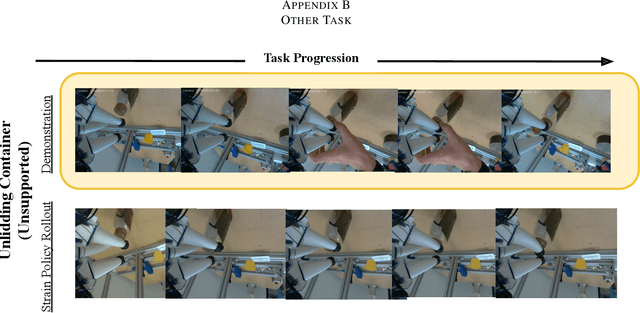
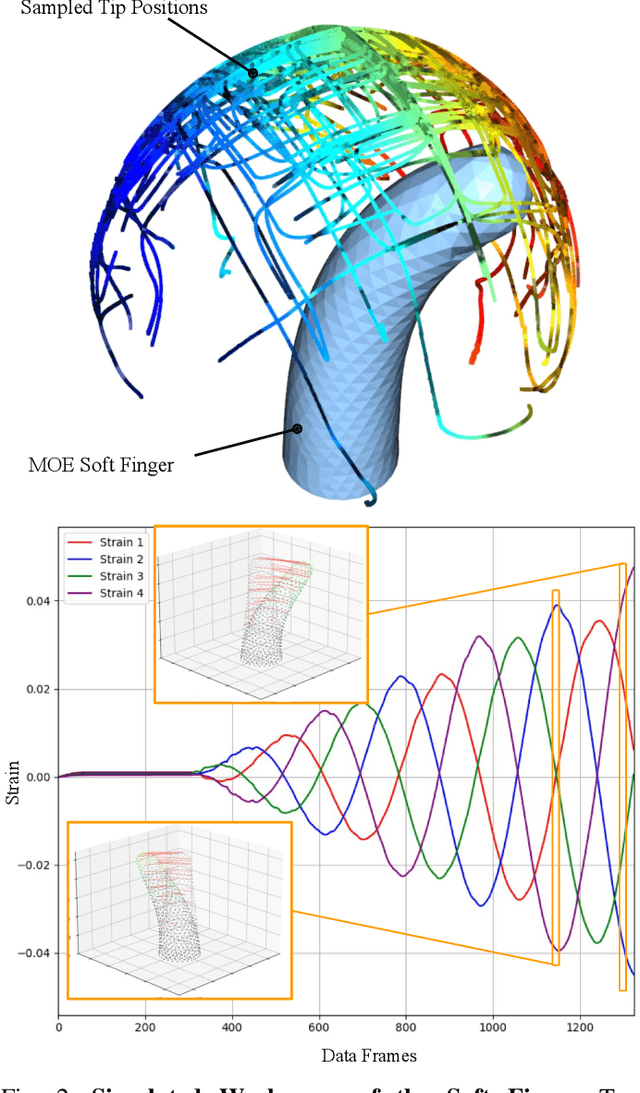
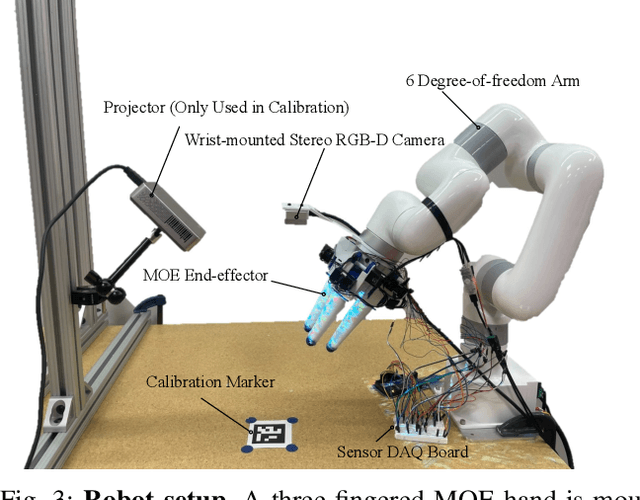
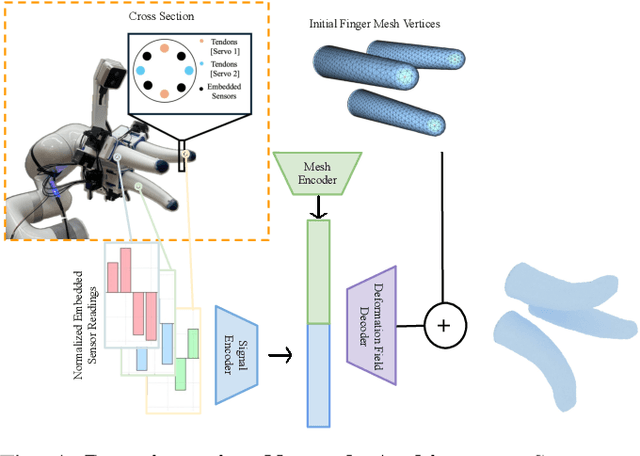
Abstract:Underactuated soft robot hands offer inherent safety and adaptability advantages over rigid systems, but developing dexterous manipulation skills remains challenging. While imitation learning shows promise for complex manipulation tasks, traditional approaches struggle with soft systems due to demonstration collection challenges and ineffective state representations. We present KineSoft, a framework enabling direct kinesthetic teaching of soft robotic hands by leveraging their natural compliance as a skill teaching advantage rather than only as a control challenge. KineSoft makes two key contributions: (1) an internal strain sensing array providing occlusion-free proprioceptive shape estimation, and (2) a shape-based imitation learning framework that uses proprioceptive feedback with a low-level shape-conditioned controller to ground diffusion-based policies. This enables human demonstrators to physically guide the robot while the system learns to associate proprioceptive patterns with successful manipulation strategies. We validate KineSoft through physical experiments, demonstrating superior shape estimation accuracy compared to baseline methods, precise shape-trajectory tracking, and higher task success rates compared to baseline imitation learning approaches.
Sample-Efficient Behavior Cloning Using General Domain Knowledge
Jan 27, 2025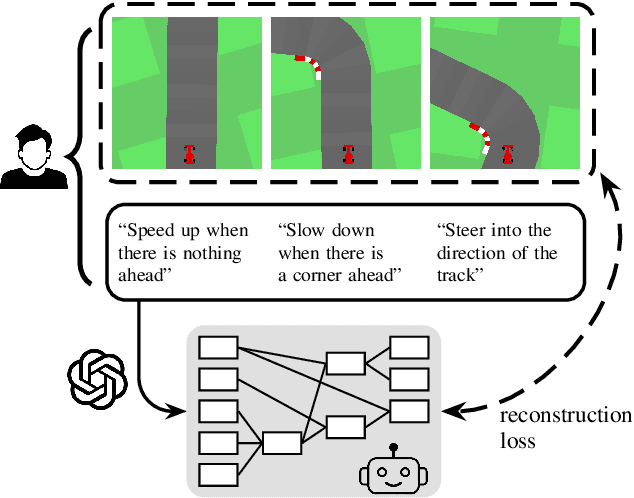

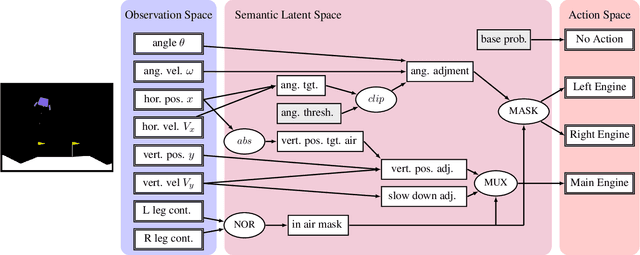

Abstract:Behavior cloning has shown success in many sequential decision-making tasks by learning from expert demonstrations, yet they can be very sample inefficient and fail to generalize to unseen scenarios. One approach to these problems is to introduce general domain knowledge, such that the policy can focus on the essential features and may generalize to unseen states by applying that knowledge. Although this knowledge is easy to acquire from the experts, it is hard to be combined with learning from individual examples due to the lack of semantic structure in neural networks and the time-consuming nature of feature engineering. To enable learning from both general knowledge and specific demonstration trajectories, we use a large language model's coding capability to instantiate a policy structure based on expert domain knowledge expressed in natural language and tune the parameters in the policy with demonstrations. We name this approach the Knowledge Informed Model (KIM) as the structure reflects the semantics of expert knowledge. In our experiments with lunar lander and car racing tasks, our approach learns to solve the tasks with as few as 5 demonstrations and is robust to action noise, outperforming the baseline model without domain knowledge. This indicates that with the help of large language models, we can incorporate domain knowledge into the structure of the policy, increasing sample efficiency for behavior cloning.
Soft and Compliant Contact-Rich Hair Manipulation and Care
Jan 05, 2025



Abstract:Hair care robots can help address labor shortages in elderly care while enabling those with limited mobility to maintain their hair-related identity. We present MOE-Hair, a soft robot system that performs three hair-care tasks: head patting, finger combing, and hair grasping. The system features a tendon-driven soft robot end-effector (MOE) with a wrist-mounted RGBD camera, leveraging both mechanical compliance for safety and visual force sensing through deformation. In testing with a force-sensorized mannequin head, MOE achieved comparable hair-grasping effectiveness while applying significantly less force than rigid grippers. Our novel force estimation method combines visual deformation data and tendon tensions from actuators to infer applied forces, reducing sensing errors by up to 60.1% and 20.3% compared to actuator current load-only and depth image-only baselines, respectively. A user study with 12 participants demonstrated statistically significant preferences for MOE-Hair over a baseline system in terms of comfort, effectiveness, and appropriate force application. These results demonstrate the unique advantages of soft robots in contact-rich hair-care tasks, while highlighting the importance of precise force control despite the inherent compliance of the system.
Stabilizing Reinforcement Learning in Differentiable Multiphysics Simulation
Dec 16, 2024



Abstract:Recent advances in GPU-based parallel simulation have enabled practitioners to collect large amounts of data and train complex control policies using deep reinforcement learning (RL), on commodity GPUs. However, such successes for RL in robotics have been limited to tasks sufficiently simulated by fast rigid-body dynamics. Simulation techniques for soft bodies are comparatively several orders of magnitude slower, thereby limiting the use of RL due to sample complexity requirements. To address this challenge, this paper presents both a novel RL algorithm and a simulation platform to enable scaling RL on tasks involving rigid bodies and deformables. We introduce Soft Analytic Policy Optimization (SAPO), a maximum entropy first-order model-based actor-critic RL algorithm, which uses first-order analytic gradients from differentiable simulation to train a stochastic actor to maximize expected return and entropy. Alongside our approach, we develop Rewarped, a parallel differentiable multiphysics simulation platform that supports simulating various materials beyond rigid bodies. We re-implement challenging manipulation and locomotion tasks in Rewarped, and show that SAPO outperforms baselines over a range of tasks that involve interaction between rigid bodies, articulations, and deformables.
SonicBoom: Contact Localization Using Array of Microphones
Dec 13, 2024



Abstract:In cluttered environments where visual sensors encounter heavy occlusion, such as in agricultural settings, tactile signals can provide crucial spatial information for the robot to locate rigid objects and maneuver around them. We introduce SonicBoom, a holistic hardware and learning pipeline that enables contact localization through an array of contact microphones. While conventional sound source localization methods effectively triangulate sources in air, localization through solid media with irregular geometry and structure presents challenges that are difficult to model analytically. We address this challenge through a feature engineering and learning based approach, autonomously collecting 18,000 robot interaction sound pairs to learn a mapping between acoustic signals and collision locations on the robot end effector link. By leveraging relative features between microphones, SonicBoom achieves localization errors of 0.42cm for in distribution interactions and maintains robust performance of 2.22cm error even with novel objects and contact conditions. We demonstrate the system's practical utility through haptic mapping of occluded branches in mock canopy settings, showing that acoustic based sensing can enable reliable robot navigation in visually challenging environments.
Spline-FRIDA: Towards Diverse, Humanlike Robot Painting Styles with a Sample-Efficient, Differentiable Brush Stroke Model
Nov 30, 2024Abstract:A painting is more than just a picture on a wall; a painting is a process comprised of many intentional brush strokes, the shapes of which are an important component of a painting's overall style and message. Prior work in modeling brush stroke trajectories either does not work with real-world robotics or is not flexible enough to capture the complexity of human-made brush strokes. In this work, we introduce Spline-FRIDA which can model complex human brush stroke trajectories. This is achieved by recording artists drawing using motion capture, modeling the extracted trajectories with an autoencoder, and introducing a novel brush stroke dynamics model to the existing robotic painting platform FRIDA. We conducted a survey and found that our open-source Spline-FRIDA approach successfully captures the stroke styles in human drawings and that Spline-FRIDA's brush strokes are more human-like, improve semantic planning, and are more artistic compared to existing robot painting systems with restrictive B\'ezier curve strokes.
 Add to Chrome
Add to Chrome Add to Firefox
Add to Firefox Add to Edge
Add to Edge